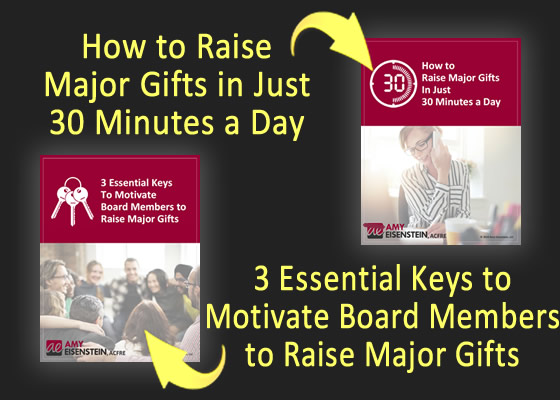
Imagine this…
Your board president starts a meeting by letting every board member know that you are counting on 100% board participation this year. (She’s off to a good start.) Then she proceeds to hand out a pledge form and asks people to send it in before the next meeting. She then calls for approval of last month’s minutes.
That’s it.
The effort and expectation put into board giving for the entire year. You can imagine what happens next:
- One or two board members return their forms promptly with generous gifts
- A small handful of board members turn in their forms over the next few weeks with disappointing gifts
- More than half don’t turn in the form at all
Sound familiar?
Remember — Your Board Leads by Example
Raising money from your board members is one of the most important steps in creating a strong culture of philanthropy within your nonprofit. Your board leads by example and sets the tone for the rest of your donors and your fundraising.
If board members are fully invested in your mission, others will be more likely to follow. However, asking board members for financial contributions requires strategy, tact, and a thoughtful approach. There’s a right way and a wrong way to solicit board members.
In my experience, a vast majority of nonprofits are still soliciting the board ineffectively like in the example above. Read on to find out how your organization is doing, and plan to do even better this year.
3 WRONG Ways to Ask Board Members for Gifts
Engaging board members in meaningful conversations about their contributions ensures they feel valued and invested in your organization’s success. With that in mind, avoid making the following three mistakes:
- Asking at a board meeting — Board meetings should focus on governance, strategy, and mission. Asking for gifts in a group setting can lead to smaller, more obligatory gifts rather than meaningful ones. You can use a board meeting to discuss broad-based fundraising plans and let board members know they will each be contacted to discuss their gift.
- Sending an email request — A personal commitment requires a personal conversation and approach. Group emails can easily be ignored or treated as a routine request rather than a significant opportunity to contribute.
- Soliciting as a group — If you ask all board members at once (often done at a board meeting – and a pledge form is distributed), it eliminates the opportunity for meaningful discussions about their capacity to give and their philanthropic priorities. It also makes it easier for individuals to give less than they might otherwise.
3 RIGHT Ways to Ask Board Members for Gifts
To inspire board members to give generously, follow these three best practices:
- Ask One-on-One — Schedule individual conversations with each board member. This allows for a deeper discussion about their giving history, motivations, and potential impact on the organization. In this format, you’ll ask for a specific amount from each board member depending on their giving history, interest level, and financial capacity.
- Be Specific About the Ask — As mentioned above, instead of a vague request, present a thoughtful and appropriate suggested gift amount based on past giving, their financial capacity, and their engagement with your nonprofit.
- Have a Peer Make the Ask — Board members are more likely to respond positively when asked by a fellow board member, rather than staff. Create a small board solicitation committee to come up with ask amounts and to lead these conversations.
How to Create a Board Solicitation Strategy
To maximize board giving, follow these key steps:
- Form a Board Solicitation Committee — Recruit a few key board members to help develop ask amounts and lead solicitation meetings.
- Review Past Giving — Understand what each board member has contributed in the past to set reasonable expectations for future giving.
- Set a Board Giving Goal — Whether it’s 100% participation or a collective financial target, having a goal keeps everyone accountable.
- Make the Case for Support — Clearly communicate why their support is needed, what impact their gift will have, and how it aligns with their role as a board member.
- Follow Up and Show Gratitude — After each ask, follow up with a thank-you note or a personal message to acknowledge their commitment and generosity.
Your board members are already passionate about your mission. Your job is to guide them toward making a financial investment that reflects that passion and to help them lead by example regarding fundraising.
By asking individually, making thoughtful asks, and engaging fellow board members in the process, you can foster a culture of giving that strengthens your entire organization.

Leave a Comment